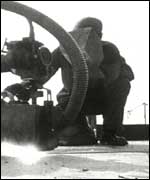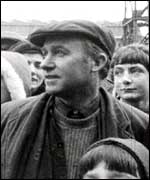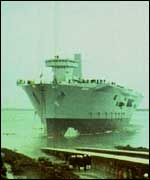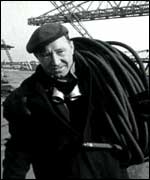|
Shipbuilding's boom years came in the early 20th century stimulated by the build up of demand for warships and ship repair yards. Then came the steepest slump on record, with heavy job losses and unemployment.
 |
|
A Wearside welder |
By the mid 1920s, the unemployment rate in the shipyards was over 40%.
Jarrow, a shipbuilding community, was one of the worst hit areas with unemployment reaching 74% at the height of the Depression.
The Second World War once again brought prosperity followed by a brief revival in the 1950s but this was short lived. From the early 1960s the yards struggled to find work with a lack of orders and increasing competition.
Ships on Tyne
The Swan Hunter yard in Newcastle was originally part of the Neptune shipyard founded at Low Walker in 1860. The yard's first ship was the Victoria, a paddle steamer launched in the same year.
 |
|
Wearsiders watch the launch of a ship in the 1960s |
In 1880 Swan Hunter became a business, and launched ships that became famous worldwide including the Mauretania, the 'queen of the ocean', which was launched in Wallsend in 1906.
The yard went on to build the Carpathia in 1912, which braved icebergs to rescue the survivors of the Titanic, and the Dominion Monarch, the largest diesel motor driven ship in the world when completed in 1939.
Over its history Swans launched over 1600 ships ranging from cargo liners, ferries and ice breakers to destroyers, frigates and submarines.
In the late 1960s Swan Hunter built eight supertankers including the Esso Northumbria, the first new-style supertanker in 1969.
Swans also went on to produce modern day aircraft carriers like the HMS Ark Royal and the HMS Illustrious in the 1980s.
At its peak the yard employed 3,000 men but competition from abroad increased, resulting in job losses and periods of stagnation.
In May 1993 the receivers were called in and job losses of over 2,000 were announced. In the mid 1990s Swan Hunter Tyneside was formed.
Naval shipbuilding
 |
|
Invincible is launched at Barrow |
Barrow has a long history of naval shipbuilding with Vickers having developed a reputation for naval shipbuilding.
The Iron Shipbuilding Company was founded in 1871 by James Ramsden, General Manager of the Furness Railway Company who became first mayor of the new town of Barrow.
The name of the yard was changed to the Barrow Ship Building Company (BSBC) when it was discovered that there was already another company building iron ships further down the coast at Birkenhead. At the end of the 19th century the company was bought by Vickers.
In 1901 Vickers was awarded the contract for the Royal Navy's first ever submarines. Britain's first nuclear submarine 'Dreadnought' and first Polaris-armed ballistic nuclear submarine 'Resolution' were also built at the yard.
The HMS Invincible was one of the many ships built by the yard, and it was one of the largest ever ships commissioned by the Royal Navy.
The building of the Invincible created 30,000 related jobs, and the ship itself was launched in the Queen's Jubilee year.
Where ships were born
Wearside has a proud 600 year history of shipbuilding dating back to 1346 when Thomas Menville was recorded as building vessels.
 |
|
Shipyard worker on the Wear in the 1960s |
In 1840 Sunderland had 65 shipyards, and by the mid twentieth century, the town produced more than a quarter of the nation's total tonnage of merchant and naval ships for World War Two.
Sunderland was once dubbed 'the largest shipbuilding town in the world', and employed a wide variety of shipyard workers - bumpers up, holders down, rivet catchers, welders, foremen, ship fitters, tuners and boiler makers to name a few.
In the boom year of the early 1900s, the yards employed over 12,000 men, a third of the town's adult population.
Sunderland's original yards were owned by local families – Bartrams, Doxfords, Pickersgills, Shorts and Thompsons among them.
When the shipbuilding industry was nationalised in 1977, British Shipbuilders took over most of the larger yards.
But competition from Japan and Korea was intense, and the yards suffered from shrinking order books.
Despite heavy investment in new technology and massive protest, Sunderland's last shipyards were closed down in 1988 and are now a distant memory for the thousands who used to work in them.
|

